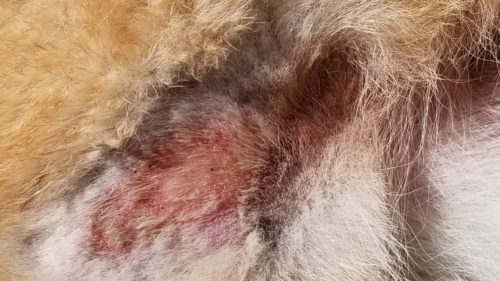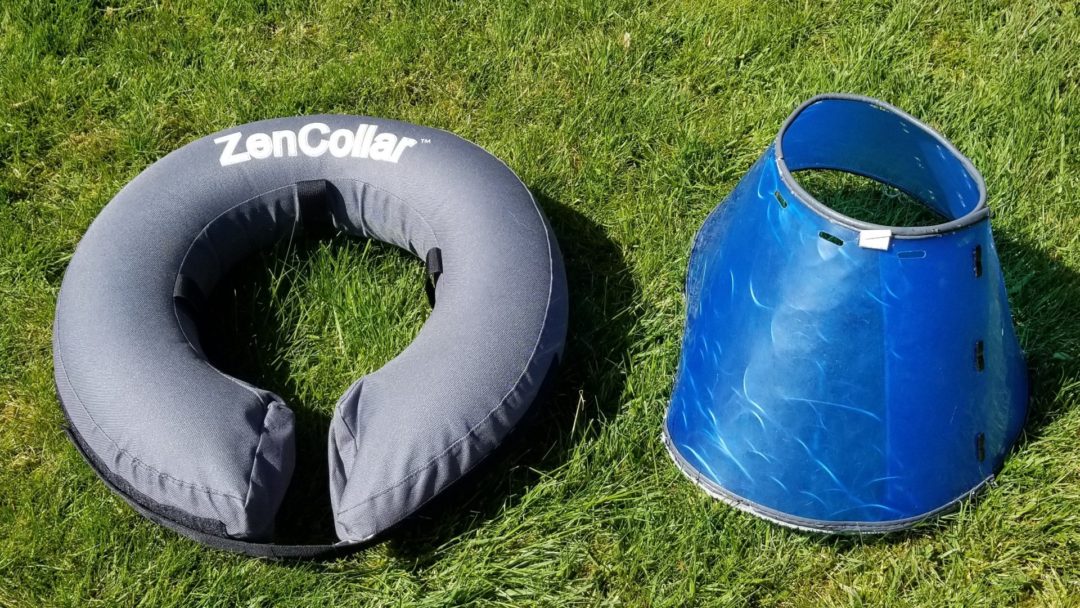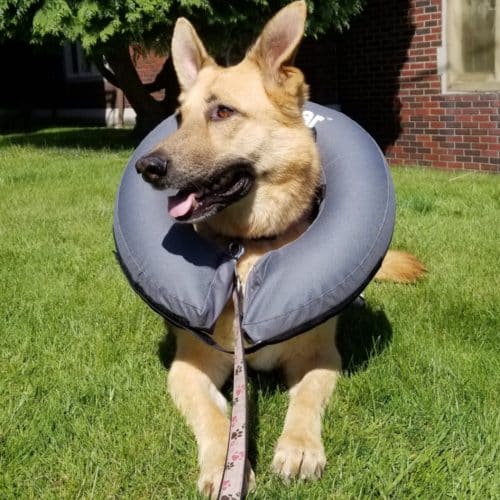Hot spots in dogs are a warm, sore, infected spot on a dog’s skin. They usually appear quite suddenly and are painful and extremely itchy for the dog. In many cases, you can treat them at home, but they can escalate and require the help of a veterinarian.
In technical terms, hot spots are known as pyotraumatic dermatitis or acute moist dermatitis. Dermatitis means inflammation of the skin, and pyo signifies the presence of pus or infection.
Let’s find out what causes hot spots to develop and how to diagnose them. If your dog has a hot spot, don’t worry we will discuss in detail what first aid treatment you can do at home and when you should bring your dog to the vet, we have all the bases covered!
What Do Hot Spots Look Like?
A typical hot spot appears as a red, round, inflamed area of skin, covered with moist and matted hair. The lesions can quickly become smelly, oozy and filled with pus, especially in warm weather. Hot spots can vary in size and number and can be found anywhere on a dog’s body, with the head, neck, legs and hips being the most commonly affected areas.
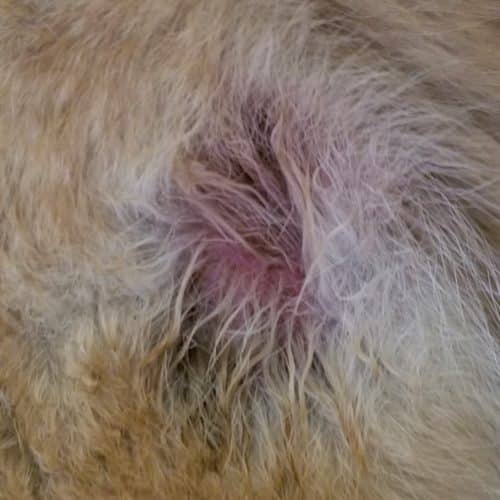
Often an owner will notice a tiny red spot on their dog’s skin, then a few hours later, a much larger, red, raw lesion will have developed. There can be quite a dramatic change in a short period of time.
Skin lesions are not very nice for the dog, and it can be very frustrating for an owner to watch their dog suffer. Dogs will often scratch and lick frantically at their sore skin trying to ease their discomfort.
What Causes Hot Spots in Dogs?
Hot spots are usually caused by a dog scratching itself so much that it breaks the skin. The dog then licks and scratches the area some more, causing the skin to become sore and inflamed. It creates a cycle of self-trauma and causes the hot spot to increase in size.
All dogs have a small number of normal bacteria which live on the surface of their skin, but staphylococcus intermedius is the most common bacteria found in dog hot spots. A warm, moist, itchy hot spot offers the perfect environment for the bacteria to multiply, and the break in the skin barrier (or wound) allows the bacteria to move deeper into the skin than normal. All this causes pain and inflammation, which just causes the dog to scratch more. It becomes a never-ending cycle!
Let’s Take a Look at the Most Common Causes of Self-Trauma:
1. Allergies
Allergies, including food or environmental allergies, can cause intense itching.
2. Parasites and Insect Bites
Flea bites are thought to be the most common cause of hot spots, but other parasites and insect bites, such as mites (sarcoptes, demodex, cheyletiella), ticks or bee stings, may cause scratching too.
3. Ear Infections
An overgrowth of bacteria, yeast or ear mites (otodectes) can cause ear scratching and hot spots on the ear flaps, head or neck.
4. Matted or Tangled Hair
Matted hair or tangles create the perfect environment for bacteria to overgrow. They are more common in dogs with longer or thicker hair. The matted coat traps moisture and pus, prevents air from circulating to the skin and retains water after a swim or after being in the rain. This can cause irritation, itching and scratching.
5. Arthritis
Arthritis can cause dogs to lie down more than usual, which can lead to pressure sores and abrasions developing on areas where there are small bony protrusions (hips, hocks, elbows, etc.), and little muscle padding (especially in senior dogs who tend to lose their muscle mass). The dog will often lick at the pressure point, or other arthritic joints that are sore to relieve the pain, creating a hot spot. It is important to offer an old, arthritic dog a well padded, comfortable bed to sleep on and seek veterinary advice for pain relief for their arthritis.
6. Boredom
Boredom can cause dogs to develop all sorts of bad habits and repetitive behaviours such as licking or chewing their feet and legs. It is similar to people biting their fingernails when stressed.
7. Anal Gland Problems
Anal gland infections, impactions (blockage) or other problems can be uncomfortable for a dog. They try to lick the area or drag their bottom on the ground to relieve the pain, but end up creating a hot spot in the area.
There are lots of different reasons why a dog may develop a hot spot, but they all start with the dog itching or chewing the area and breaking the skin. Although any breed of dog can be affected, hot spots are more common in longer haired dogs and those with thicker, denser coats. Hot spots occur more frequently in hot weather and are sometimes called summer eczema.
How are Hot Spots Diagnosed?
It is quite simple to diagnose a hot spot due to its distinctive and sudden appearance on the skin. If you notice your dog fussing with an area, take a good look at it to inspect for a red sore on your dog’s skin.
Should You Take Your Dog to the Vet for a Hot Spot?
If the hot spot is small and uncomplicated, it can be treated at home. They can be painful and increase in size quickly, therefore, it may be safer and easier to get your veterinarian to deal with it from the start. Any dog may snap due to pain and act out, even if they are usually very well behaved.
If your dog has any other signs of illness, such as lethargy, decreased appetite, gastrointestinal symptoms (vomiting or diarrhea) or lameness, then it is best to seek veterinary advice sooner rather than later.
If you choose to treat the hot spot at home, but there is no improvement within 24 hours, then take your dog to the vet. Hot spots are sore and uncomfortable for your dog, so there is no point waiting longer if your home first aid is not making the problem better.
If your dog continues to develop hot spots regularly, steps should be taken to diagnose and treat any underlying reasons (e.g., allergies, ear infections, matted hair, arthritis). This investigation is best undertaken with the help of your veterinarian. A microscopic examination of the skin may be necessary to check for skin diseases or parasites, a swab taken for bacterial culture, or x-rays taken to check for signs of arthritis.
How do You Treat Hot Spots?
The first step is to clip the hair in the affected area to expose the hot spot. Hot spots can be extremely painful, and the dog may need sedation to allow proper treatment. Once the hair is removed, thoroughly flush with sterile saline to clean the area, then disinfect using a diluted chlorhexidine rinse or a chlorhexidine shampoo. Make sure to rinse thoroughly so there are no traces of the disinfectant.
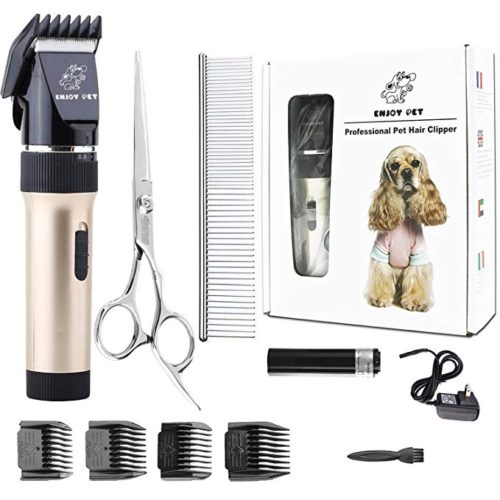
Pet Hair Clippers
The ongoing treatment depends on the size and severity of the hot spot. Small hot spots are often managed with daily cleaning and a topical soothing anti-inflammatory cream or spray. Larger, more serious and painful hot spots may also require a combination of topical, oral or injectable medications such as antibiotics (if infection is present), pain relief (e.g., NSAIDs) or anti-inflammatories (e.g., corticosteroids to rapidly reduce inflammation, itchiness and redness).
While the hot spot heals, you must prevent the dog from licking the area. This is usually achieved by using an E-Collar (Elizabethan Collar), also known as the cone of shame. The area should not be bandaged or covered with a dressing, as it will heal much faster if it is allowed to be dry and open to the air.
Do Over the Counter Treatments Work for Hot Spots?
Yes, simple hot spots can usually be managed and treated successfully at home with over the counter treatments. However, it is possible for the hot spot to worsen if not treated quickly and properly.
The hot spot can be flushed with tap water or sterile saline, and then disinfected using diluted chlorhexidine diacetate solution which can be bought from a pharmacy. Chlorhexidine needs to be diluted, as the full strength solution can cause damage to skin cells and delay wound healing. To safely dilute chlorhexidine add 2 tablespoons of solution into 1 gallon (3.7 litres) of clean water.
Allow the hot spot to dry and then apply a mild over the counter antibiotic/corticosteroid (hydrocortisone) cream to the area. A small amount of cream can be applied to the area 3-4 times daily. This type of cream targets and treats infection and inflammation, quickly reducing the itchiness of the hot spot.
It is important to remember that many human medications are not safe for dogs and a human dose may be toxic to your pet (e.g. Tylenol, Advil). It is always best to seek veterinary advice before using over the counter medications.
How Long Does it Take for a Hot Spot to Heal?
The time for the hot spot to heal depends on the size and severity of the hot spot. Small, simple hot spots can quickly heal in a few days. Larger hot spots can take 1- 2 weeks for the area to fully heal, and 4-8 weeks for the hair to fully regrow. Following the start of treatment, the dog should be more comfortable within 24hours, with the area looking a little less red.
Does My Dog Need to Wear The Cone of Shame?
Yes, yes and yes! Unfortunately, your dog will need to wear the cone of shame for at least a few days while the treatment works to reduce the redness, inflammation and itchiness. Without a cone, also known as an E-Collar, your efforts to treat the dog hot spot will be in vain, as it is the dog’s natural response to lick the area. Unfortunately, contrary to what a lot of people think, licking the area does not encourage it to heal, in fact, it delays wound healing.
There are many types of E-Collars available from the traditional plastic cone, to cloth collars or inflatable cushion collars. The plastic cones, although more uncomfortable and embarrassing for your dog, are usually the most effective at preventing your dog from reaching the hot spot, especially if your dog has a longer nose. They wipe clean, which is handy, but can easily break or crack if your dog is particularly boisterous.
Inflatable cones are very comfortable, more aesthetically pleasing and very durable. However, they don’t extend out very far, therefore, work best for short-nosed dogs. Cloth cones look nice and appear comfortable but are easily collapsible if your dog really wants to get to that hot spot, so aren’t a good option for the determined or active dog.
Whichever cone you choose it should be properly fitted, too loose and the dog will easily remove it, too tight and the dog will feel very uncomfortable.
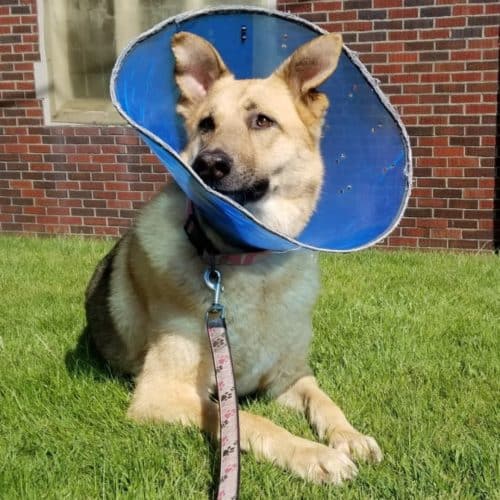
Elizabethan Plastic Collars
ZenPet Pro Pet E-Collar For Dogs
How Can You Prevent Dog Hot Spots?
Some dogs get a hot spot once and then never get one ever again, other dogs seem to get them regularly. If your dog is one of the unfortunate ones prone to developing hot spots here are a few tips on how you can help prevent them in the future:
Some dogs get a hot spot once and then never get one ever again, other dogs seem to get them regularly. If your dog is one of the unfortunate ones prone to developing hot spots here are a few tips on how you can help prevent them in the future:
- Check your dog’s skin daily.
- Use good flea control year round.
- Consider clipping the coat in summer or perform daily brushing.
- Regular baths with an antibacterial shampoo (e.g. Malaseb).
- Regular checks of the ears (if prone to ear infections).
- Regular checks of the anal glands (if prone to infections or impactions)
If your dog does develop hot spots regularly then steps should be taken to diagnose the underlying cause, so that options for treatment and prevention can be more specific.
Conclusion
Hot spots in dogs are frustrating, these red, painful lesions appear rapidly and are extremely itchy. They can easily double in size within a few hours if the dog is allowed to lick and scratch. Fortunately, if it is a simple hot spot then it can often be treated successfully at home. However, as they can be painful lesions for your dog, it may be easier and safer for your vet to deal with. Carefully clipping the hair and cleaning the area are the most important steps, along with using an E-Collar for a few days to prevent your dog from licking the area. Remember if your dog is showing other signs of being unwell or you aren’t seeing any improvement within 24 hours of home treatment then you should seek help from your vet.
References
- B., R. Holm, J., R., Rest, W., Seewald. (2004) A prospective study of the clinical findings, treatment and histopathology of 44 cases of pyotraumatic dermatitis. Vet Dermatol. 2004 Dec;15(6):369-76. https://www.ncbi.nlm.nih.gov/pubmed/15585012
- C., Noli, A., Foster, W., Rosenkrantz. (2013) E., Bensignor, Chapter 22, Clinical Signs of Flea Allergy Dermatitis in Dogs. Veterinary Allergy. Print ISBN:9780470672419 |Online ISBN:9781118738818 |DOI:10.1002/9781118738818. https://onlinelibrary.wiley.com/doi/pdf/10.1002/9781118738818.ch22


